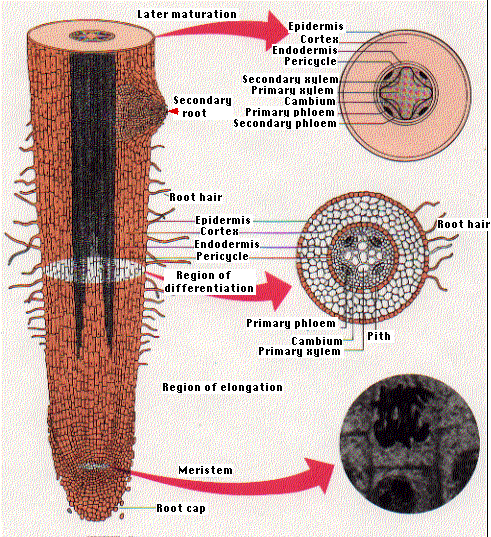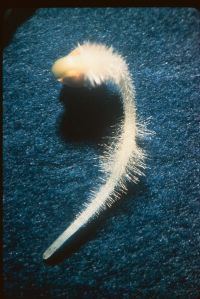 The root tip consists of a
The root tip consists of a
- meristem - a region of rapid mitosis, which produces the new cells for root growth.
- root cap - a sheath of cells that protects the meristem from abrasion and damage as the root tip grows through the soil.
Because of the frequency of mitosis in the meristem, root tips are often used to demonstrate mitosis in the laboratory The inset is a photo (courtesy of Carolina Biological Supply Co.) of anaphase in the meristem of an onion root tip.
Here the cells produced by mitosis undergo a period of elongation in the direction of the axis of the root. It is at this time that they are sensitive to gravity and respond with gravitropism.
Here develop the differentiated tissues of the root.
- Epidermis. A single layer of flattened cells at the surface. When first formed, epidermal cells have extensions - the root hairs - which greatly increase the surface area available for the uptake of water from the soil. The photo below shows the root hairs in the region of differentiation of a germinating radish seed.

- Cortex. A band of parenchyma cells that develops beneath the epidermis. It stores food. Its inner surface is bounded by a single layer of cells, the
- Endodermis.
- Stele
- Pericycle - the outer boundary of the stele. Secondary roots branch from it.
- Xylem - arranged in bundles in a spokelike fashion
- Phloem - alternates with xylem
- Cambium - In older parts of the root, another meristem forms between the xylem and phloem. Mitosis in the cambium produces new "secondary xylem" to the inside and secondary phloem to the outside.
Water enters the root through the root hairs. These extensions of epidermal cells have sticky walls and adhere tightly to soil particles with their film of moisture.
Once within the epidermis, water passes through the cortex, mainly traveling between the cells. However, in order to enter the stele, it must pass through the cytoplasm of the cells of the endodermis.
Once within the stele, water is free again to move between cells as well as through them.
In young roots, water enters directly into the xylem. In older roots, it may have to pass first through a band of phloem and cambium. It does so by traveling through horizontally-elongated cells, the xylem rays.
One might have expected that minerals would enter the root dissolved in water. But, in fact, minerals enter separately:
- Even when no water is being absorbed, minerals enter freely.
- Minerals can enter against their concentration gradient; that is, by active transport.
- Anything that interferes with the metabolism of root cells interferes with mineral absorption.
For examples:
- nitrogen enters as nitrate (NO3-) or ammonium ions (NH4+)
- phosphorus as PO43-
- potassium as K+
- calcium as Ca2+
When you hear of the virtues of organic fertilizers, remember that such materials meet no nutritional need of the plant until their constituents have been degraded to inorganic forms. Organic matter does play an important role in making good soil texture, but only to the extent that it can yield inorganic ions can it meet the nutritional needs of the plant.
Once within the epidermis, inorganic ions pass inward from cell to cell, probably through plasmodesmata. The final step from the cytoplasm of the pericycle cells to the xylem is probably accomplished once again by active transport.
The older parts of roots are sheathed in layers of dead cork cells impregnated with a waxy, waterproof (and airproof) substance called suberin. This sheath reduces water loss but is as impervious to oxygen and carbon dioxide as it is to water.
However, the cork is perforated by nonsuberized pores called lenticels. These permit the exchange of oxygen and carbon dioxide between the air and the living cells beneath.
28 September 2005


